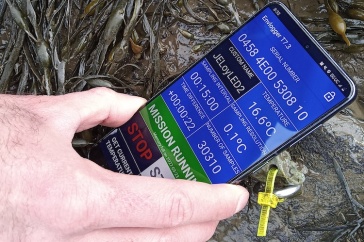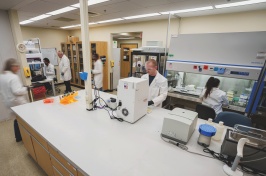UNH Research Offers Better Measurement for Lethal Impact of Marine Heatwaves

DURHAM, N.H. — Prolonged heatwaves on land can have serious implications for humans, animals and landscapes, and there’s mounting evidence that periods of unusually high sea temperatures, known as marine heatwaves, can also severely harm ocean ecosystems. However, measuring the impact of marine heatwaves on marine life has proven challenging and does not take into consideration biological changes in organisms. Recent research at the University of New Hampshire finds that to get a better assessment of the impact of marine heatwaves it is important to look at not only temperature in the environment but also the physical responses of marine organisms across different intensities and lengths of heatwaves.
"Traditional statistical methods fall short because they ignore the biological responses of organisms,” said Easton White, assistant professor of biological sciences and a scientist in UNH’s New Hampshire Agricultural Experiment Station. “Our physiological framework takes into account how marine organisms respond to both the intensity and duration of heat stress, offering a much clearer understanding of the lethal impacts and a crucial approach for predicting how these extreme events will affect marine ecosystems and for developing strategies to mitigate their effects.”
White, along with Andrew Villeneuve, a doctoral student in UNH's marine biology program, outline their approach in a study published in the Journal of Animal Ecology. The paper looks at the thermal tolerances of three different species of bivalves, or clams, when exposed to varying durations of heat stress. Using simulation models that assessed the deadly effects of marine heatwaves based on organismal response, they found that both short, intense heatwaves (acute events) and longer, milder heatwaves (chronic events) can be equally deadly to marine organisms. The results help to advance existing research and monitoring efforts by highlighting that the more frequent, short bursts of extreme heat can be just as harmful as longer heatwaves.
"By understanding the specific survival thresholds for different marine species, our research can provide insight into how various heatwave profiles impact marine life," said Villeneuve. "This understanding is key for developing more effective conservation and management strategies to protect vulnerable marine ecosystems."
They suggest that if a specific marine species is found to be highly susceptible to short, intense heatwaves, conservation measures might focus on creating refuges or cooler microhabitats during these peak heat periods to help ensure their survival.
The researchers stress that the importance of a more physiological framework will become essential as climate change and ocean warming continue. They believe that integrating these dynamic thermal tolerance models with other ecological models will offer a more comprehensive view of how marine heatwaves affect entire ecosystems.
The researchers are currently running lab experiments and doing field work to support these models and better understanding how marine species acclimate to different heat conditions over varying periods.
Funding for this work was provided by the USDA National Institute of Food and Agriculture, N.H. Agricultural Experiment Station and the state of New Hampshire. Additional support came from a N.H. Sea Grant fellowship.
FIGURES & PHOTOS FOR DOWNLOAD
Photo: marine-heatwaves-oyster-monitoring
Caption: A researcher measures intertidal temperatures to better understand how oysters in New Hampshire’s Great Bay may experience heatwaves.
Photo credit: University of New Hampshire
Figure 1: Gulf of Maine Marine Heatwaves-Summer 2021.pdf
Caption: Marine heatwaves in the Gulf of Maine during the summer 2021, categorized by their intensity. However, this approach relies on statistical analysis, and may not accurately reflect how organisms experience heatwaves.
Credit: Easton White, Andrew Villeneuve
Figure 2: Gulf of Maine Marine Heatwaves Trend-1993-2022.pdf
Caption: Map showing the increase in Marine Heatwave events from 1993-2022.
Credit: Easton White, Andrew Villeneuve
About UNH
The University of New Hampshire inspires innovation and transforms lives in our state, nation and world. More than 16,000 students from 50 states and 87 countries engage with an award-winning faculty in top-ranked programs in business, engineering, law, health and human services, liberal arts and the sciences across more than 200 programs of study. A Carnegie Classification R1 institution, UNH partners with NASA, NOAA, NSF, and NIH, and received over $210 million in competitive external funding in FY23 to further explore and define the frontiers of land, sea and space.
Latest News
-
June 25, 2025
-
June 16, 2025
-
June 6, 2025
-
May 15, 2025
-
May 14, 2025
















































